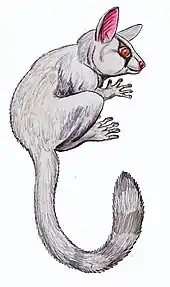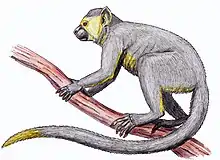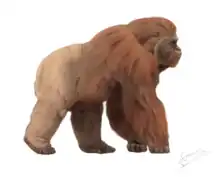| Chimpanzees and bonobos[1] | |
|---|---|
_and_male_bonobo_(right).jpg.webp) | |
| Members of the genus Pan: chimpanzee (left) and bonobo (right) | |
| Scientific classification | |
| Domain: | Eukaryota |
| Kingdom: | Animalia |
| Phylum: | Chordata |
| Class: | Mammalia |
| Order: | Primates |
| Suborder: | Haplorhini |
| Infraorder: | Simiiformes |
| Family: | Hominidae |
| Subfamily: | Homininae |
| Tribe: | Hominini |
| Subtribe: | Panina Delson, 1977[2] |
| Genus: | Pan Oken, 1816 |
| Type species | |
| Simia troglodytes | |
| Species | |
_distribution_map.svg.png.webp) | |
| Distribution of Pan troglodytes (common chimpanzee) and Pan paniscus (bonobo, in red) | |
| Synonyms | |
| |
The genus Pan consists of two extant species: the chimpanzee and the bonobo. Taxonomically, these two ape species are collectively termed panins.[4][5] The two species were formerly collectively called "chimpanzees" or "chimps"; if bonobos were recognized as a separate group at all, they were referred to as "pygmy" or "gracile chimpanzees". Together with humans, gorillas, and orangutans they are part of the family Hominidae (the great apes, or hominids). Native to sub-Saharan Africa, chimpanzees and bonobos are currently both found in the Congo jungle, while only the chimpanzee is also found further north in West Africa. Both species are listed as endangered on the IUCN Red List of Threatened Species, and in 2017 the Convention on Migratory Species selected the chimpanzee for special protection.[6]
Chimpanzee and bonobo: comparison
The chimpanzee (P. troglodytes) who lives north of the Congo River, and the bonobo (P. paniscus) who lives south of it, were once considered to be the same species, but since 1928 they have been recognized as distinct.[7] In addition, P. troglodytes is divided into four subspecies, while P. paniscus is undivided. Based on genome sequencing, these two extant Pan species diverged around one million years ago.
The most obvious differences are that chimpanzees are somewhat larger, more aggressive and male-dominated, while the bonobos are more gracile, peaceful, and female-dominated. Their hair is typically black or brown. Males and females differ in size and appearance. Both chimpanzees and bonobos are some of the most social great apes, with social bonds occurring throughout large communities. Fruit is the most important component of a chimpanzee's diet; but they will also eat vegetation, bark, honey, insects and even other chimpanzees or monkeys. They can live over 30 years in both the wild and captivity.

Chimpanzees and bonobos are equally humanity's closest living relatives. They use a variety of sophisticated tools and construct elaborate sleeping nests each night from branches and foliage. Their learning abilities have been extensively studied. There may even be distinctive cultures within populations. Field studies of Pan troglodytes were pioneered by primatologist Jane Goodall.
Names
The genus name Pan was first introduced by Lorenz Oken in 1816. While Oken did not give a rationale for his choice, it is generally thought to have been inspired by the name of the Greek god Pan.[8][9] An alternative Theranthropus was suggested by Brookes 1828 and Chimpansee by Voigt 1831. Troglodytes was not available, as it had been given as the name of a genus of wren in 1809, for "cave-dweller", reflecting the tendency of some wrens to forage in dark crevices. The International Commission on Zoological Nomenclature adopted Pan as the only official name of the genus in 1895,[10] though the "cave-dweller" connection was able to be included, albeit at the species level (Pan troglodytes – the common chimpanzee) for one of the two species of Pan.
The first use of the name "chimpanze" is recorded in The London Magazine in 1738,[11] glossed as meaning "mockman" in a language of "the Angolans" (apparently from a Bantu language; reportedly modern Vili (Civili), a Zone H Bantu language, has the comparable ci-mpenzi[12]). The spelling chimpanzee is found in a 1758 supplement to Chamber's Cyclopædia.[13] The colloquialism "chimp" was most likely coined some time in the late 1870s.[14][15]
The chimpanzee was named Simia troglodytes by Johann Friedrich Blumenbach in 1776. The species name troglodytes is a reference to the Troglodytae (literally "cave-goers"), an African people described by Greco-Roman geographers. Blumenbach first used it in his De generis humani varietate nativa liber ("On the natural varieties of the human genus") in 1776,[16][17] Linnaeus 1758 had already used Homo troglodytes for a hypothetical mixture of human and orangutan.[10]
The bonobo, in the past also referred to as the "pygmy chimpanzee", was given the species name of paniscus by Ernst Schwarz (1929), a Greek-style diminutive of the theonym Pan used by Cicero.[18]
Distribution and habitat
There are two species of the genus Pan, both previously called simply chimpanzees:
- Chimpanzees or Pan troglodytes, are found almost exclusively in the heavily forested regions of Central and West Africa. With at least four commonly accepted subspecies, their population and distribution is much more extensive than the bonobos, in the past also called 'pygmy chimpanzee'.
- Bonobos, Pan paniscus, are found only in Central Africa, south of the Congo River and north of the Kasai River (a tributary of the Congo),[19] in the humid forest of the Democratic Republic of Congo of Central Africa.
| Common name | Scientific name and subspecies | Range | Size and ecology | IUCN status and estimated population |
|---|---|---|---|---|
| Bonobo
|
P. paniscus Schwarz, 1929 |
Central Africa |
Size: 70–83 cm (28–33 in) long[20] Habitat: Forest[21] Diet: Fruits and seeds, as well as leaves, stems, shoots, pith, bark, flowers, truffles, fungus, and honey[21] |
EN
|
| Chimpanzee
|
P. troglodytes (Blumenbach, 1775) Four subspecies
|
Central and western Africa |
Size: 63–90 cm (25–35 in) long[22] Habitat: Forest and savanna[23] Diet: Fruit, leaves, stems, buds, bark, pith, seeds, and resins, as well as insects, small vertebrates, and eggs[24] |
EN
|
Evolutionary history
Evolutionary relationship
| Phylogeny of superfamily Hominoidea[25]: Fig. 4 | |||||||||||||||||||||||||||
|---|---|---|---|---|---|---|---|---|---|---|---|---|---|---|---|---|---|---|---|---|---|---|---|---|---|---|---|
|
The genus Pan is part of the subfamily Homininae, to which humans also belong. The lineages of chimpanzees and humans separated in a process of speciation between roughly five to twelve million years ago,[26] making them humanity's closest living relative.[27] Research by Mary-Claire King in 1973 found 99% identical DNA between human beings and chimpanzees.[28] For some time, research modified that finding to about 94%[29] commonality, with some of the difference occurring in noncoding DNA, but more recent knowledge states the difference in DNA between humans, chimpanzees and bonobos at just about 1%–1.2% again.[30][31]
Fossils
The chimpanzee fossil record has long been absent and thought to have been due to the preservation bias in relation to their environment. However, in 2005, chimpanzee fossils were discovered and described by Sally McBrearty and colleagues. Existing chimpanzee populations in West and Central Africa are separate from the major human fossil sites in East Africa; however, chimpanzee fossils have been reported from Kenya, indicating that both humans and members of the Pan clade were present in the East African Rift Valley during the Middle Pleistocene.[32]
Anatomy and physiology


The chimpanzee's arms are longer than its legs. The male common chimp stands up to 1.2 m (3.9 ft) high. Male adult wild chimps weigh between 40 and 60 kg[34][35][36] with females weighing between 27 and 50 kg.[35] When extended, the common chimp's long arms span one and a half times the body's height.[7] The bonobo is slightly shorter and thinner than the common chimpanzee, but has longer limbs. In trees, both species climb with their long, powerful arms; on the ground, chimpanzees usually knuckle-walk, or walk on all fours, clenching their fists and supporting themselves on the knuckles. Chimpanzees are better suited for walking than orangutans, because the chimp's feet have broader soles and shorter toes. The bonobo has proportionately longer upper limbs and walks upright more often than does the common chimpanzee. Both species can walk upright on two legs when carrying objects with their hands and arms.
_and_human.svg.png.webp)
The chimpanzee is tailless; its coat is dark; its face, fingers, palms of the hands, and soles of the feet are hairless. The exposed skin of the face, hands, and feet varies from pink to very dark in both species, but is generally lighter in younger individuals and darkens with maturity. A University of Chicago Medical Centre study has found significant genetic differences between chimpanzee populations.[37] A bony shelf over the eyes gives the forehead a receding appearance, and the nose is flat. Although the jaws protrude, a chimp's lips are thrust out only when it pouts.
The brain of a chimpanzee has been measured at a general range of 282–500 cm3.[38] The human brain, in contrast, is about three times larger, with a reported average volume of about 1330 cm3.[39]
Chimpanzees reach puberty between the age of eight and ten years.[40] A chimpanzee's testicles are unusually large for its body size, with a combined weight of about 4 oz (110 g) compared to a gorilla's 1 oz (28 g) or a human's 1.5 ounces (43 g). This relatively great size is generally attributed to sperm competition due to the polygynandrous nature of chimpanzee mating behaviour.[41][42]
Longevity
In the wild, chimpanzees live to their 30s,[43][44] while some captured chimps have reached an age of 70 years and older.[45]
Muscle strength
Chimpanzees are known for possessing great amount of muscle strength, especially in their arms. However, compared to humans the amount of strength reported in media and popular science is greatly exaggerated with numbers of four to eight times the muscle strength of a human. These numbers stem from two studies in 1923 and 1926 by a biologist named John Bauman.[46][47] These studies were refuted in 1943 and an adult male chimpanzee was found to pull about the same weight as an adult man.[48] Corrected for their smaller body sizes, chimpanzees were found to be stronger than humans but not anywhere near four to eight times. In the 1960s these tests were repeated and chimpanzees were found to have twice the strength of a human when it came to pulling weights. The reason for the higher strength seen in chimpanzees compared to humans are thought to come from longer skeletal muscle fibers that can generate twice the work output over a wider range of motion compared to skeletal muscle fibers in humans.
Behaviour
It is suspected that human observers can influence chimpanzee behaviour. For this reason researchers sometimes prefer camera traps and remote microphones rather than human observers.[49]
Chimpanzee vs. bonobo

Anatomical differences between the common chimpanzee and the bonobo are slight. Both are omnivorous adapted to a mainly frugivorous diet.[50][51] Yet sexual and social behaviours are markedly different. The common chimpanzee has a troop culture based on beta males led by an alpha male, and highly complex social relationships. The bonobo, on the other hand, has egalitarian, nonviolent, matriarchal, sexually receptive behaviour.[52] Bonobos frequently have sex, sometimes to help prevent and resolve conflicts. Different groups of chimpanzees also have different cultural behaviour with preferences for types of tools.[53] The common chimpanzee tends to display greater aggression than does the bonobo.[54] The average captive chimpanzee sleeps 9 hours and 42 minutes per day.[55]
Contrary to what the scientific name (Pan troglodytes) may suggest, chimpanzees do not typically spend their time in caves, but there have been reports of some of them seeking refuge in caves because of the heat during daytime.[56]
Chimpanzees
Social structure
Chimpanzees live in large multi-male and multi-female social groups, which are called communities. Within a community, the position of an individual and the influence the individual has on others dictates a definite social hierarchy. Chimpanzees live in a leaner hierarchy wherein more than one individual may be dominant enough to dominate other members of lower rank. Typically, a dominant male is referred to as the alpha male. The alpha male is the highest-ranking male that controls the group and maintains order during disputes. In chimpanzee society, the 'dominant male' sometimes is not the largest or strongest male but rather the most manipulative and political male that can influence the goings on within a group. Male chimpanzees typically attain dominance by cultivating allies who will support that individual during future ambitions for power. The alpha male regularly displays by puffing his normally slim coat up to increase view size and charge to seem as threatening and as powerful as possible; this behaviour serves to intimidate other members and thereby maintain power and authority, and it may be fundamental to the alpha male's holding on to his status. Lower-ranking chimpanzees will show respect by submissively gesturing in body language or reaching out their hands while grunting. Female chimpanzees will show deference to the alpha male by presenting their hindquarters.
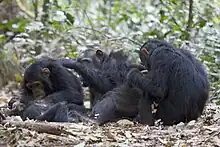
Female chimpanzees also have a hierarchy, which is influenced by the position of a female individual within a group. In some chimpanzee communities, the young females may inherit high status from a high-ranking mother. Dominant females will also ally to dominate lower-ranking females: whereas males mainly seek dominant status for its associated mating privileges and sometimes violent domination of subordinates, females seek dominant status to acquire resources such as food, as high-ranking females often have first access to them. Both genders acquire dominant status to improve social standing within a group.
Community female acceptance is necessary for alpha male status; females must ensure that their group visits places that supply them with enough food. A group of dominant females will sometimes oust an alpha male which is not to their preference and back another male, in whom they see potential for leading the group as a successful alpha male.
The mating system within each community is polygynandrous, with each male and female possibly having multiple sexual partners.[57]
Intelligence
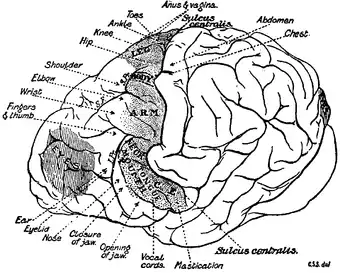
Chimpanzees make tools and use them to acquire foods and for social displays; they have sophisticated hunting strategies requiring cooperation, influence and rank; they are status conscious, manipulative and capable of deception; they can learn to use symbols and understand aspects of human language including some relational syntax, concepts of number and numerical sequence;[58] and they are capable of spontaneous planning for a future state or event.[59]
Tool use

In October 1960, Jane Goodall observed the use of tools among chimpanzees. Recent research indicates that chimpanzees' use of stone tools dates back at least 4,300 years (about 2,300 BC).[60] One example of chimpanzee tool usage behavior includes the use of a large stick as a tool to dig into termite mounds, and the subsequent use of a small stick altered into a tool that is used to "fish" the termites out of the mound.[61] Chimpanzees are also known to use smaller stones as hammers and a large one as an anvil in order to break open nuts.[62]
In the 1970s, reports of chimpanzees using rocks or sticks as weapons were anecdotal and controversial.[63] However, a 2007 study claimed to reveal the use of spears, which common chimpanzees in Senegal sharpen with their teeth and use to stab and pry Senegal bushbabies out of small holes in trees.[64][65]
Prior to the discovery of tool use by chimpanzees, humans were believed to be the only species to make and use tools; however, several other tool-using species are now known.[66][67]
Nest-building
Nest-building, sometimes considered to be a form of tool use, is seen when chimpanzees construct arboreal night nests by lacing together branches from one or more trees to build a safe, comfortable place to sleep; infants learn this process by watching their mothers. The nest provides a sort of mattress, which is supported by strong branches for a foundation, and then lined with softer leaves and twigs; the minimum diameter is 5 metres (16 ft) and may be located at a height of 3 to 45 metres (10 to 150 ft). Both day and night nests are built, and may be located in groups.[68] A study in 2014 found that the muhimbi tree is favoured for nest building by chimpanzees in Uganda due to its physical properties, such as bending strength, inter-node distance, and leaf surface area.[69]
Altruism and emotivity
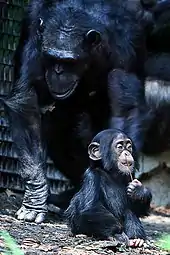
Studies have shown chimpanzees engage in apparently altruistic behaviour within groups.[70][71] Some researchers have suggested that chimpanzees are indifferent to the welfare of unrelated group members,[72] but a more recent study of wild chimpanzees found that both male and female adults would adopt orphaned young of their group. Also, different groups sometimes share food, form coalitions, and cooperate in hunting and border patrolling.[73] Sometimes, chimpanzees have adopted young that come from unrelated groups. And in some rare cases, even male chimpanzees have been shown to take care of abandoned infant chimpanzees of an unrelated group, though in most cases they would kill the infant.[74]
According to a literature summary by James W. Harrod, evidence for chimpanzee emotivity includes display of mourning; "incipient romantic love"; "rain dances"[Note 1]; appreciation of natural beauty (such as a sunset over a lake); curiosity and respect towards other wildlife (such as the python, which is neither a threat nor a food source to chimpanzees); altruism toward other species (such as feeding turtles); and animism, or "pretend play", when chimpanzees cradle and groom rocks or sticks.[75]
Communication between chimpanzees
Chimpanzees communicate in a manner that is similar to that of human nonverbal communication, using vocalizations, hand gestures, and facial expressions. There is some evidence that they can recreate human speech.[76] Research into the chimpanzee brain has revealed that when chimpanzees communicate, an area in the brain is activated which is in the same position as the language center called Broca's area in human brains.[77]
Aggression
Adult common chimpanzees, particularly males, can be very aggressive. They are highly territorial and are known to kill others of their species.[78]

Hunting
Chimpanzees also engage in targeted hunting of smaller primates, such as the red colobus[79] and bush babies.[80][81] Males who acquire the meat may share it with females to have sex or for grooming.[82]
Puzzle solving
In February 2013, a study found that chimpanzees solve puzzles for entertainment.[83]
Chimpanzees in human history

Chimpanzees, as well as other apes, had also been purported to have been known to ancient writers, but mainly as myths and legends on the edge of European and Near Eastern societal consciousness. Apes are mentioned variously by Aristotle. The English word ape translates Hebrew קוף (qof) in English translations of the Bible (1 Kings 10:22), but the word may refer to a monkey rather than an ape proper.
The diary of Portuguese explorer Duarte Pacheco Pereira (1506), preserved in the Portuguese National Archive (Torre do Tombo), is probably the first written document to acknowledge that chimpanzees built their own rudimentary tools. The first of these early transcontinental chimpanzees came from Angola and were presented as a gift to Frederick Henry, Prince of Orange in 1640, and were followed by a few of its brethren over the next several years. Scientists described these first chimpanzees as "pygmies", and noted the animals' distinct similarities to humans. The next two decades, a number of the creatures were imported into Europe, mainly acquired by various zoological gardens as entertainment for visitors.

Charles Darwin's theory of natural selection (published in 1859) spurred scientific interest in chimpanzees, as in much of life science, leading eventually to numerous studies of the animals in the wild and captivity. The observers of chimpanzees at the time were mainly interested in behaviour as it related to that of humans. This was less strictly and disinterestedly scientific than it might sound, with much attention being focused on whether or not the animals had traits that could be considered 'good'; the intelligence of chimpanzees was often significantly exaggerated, as immortalized in Hugo Rheinhold's Affe mit Schädel (see image, left). By the end of the 19th century, chimpanzees remained very much a mystery to humans, with very little factual scientific information available.
In the 20th century, a new age of scientific research into chimpanzee behaviour began. Before 1960, almost nothing was known about chimpanzee behaviour in their natural habitats. In July of that year, Jane Goodall set out to Tanzania's Gombe forest to live among the chimpanzees, where she primarily studied the members of the Kasakela chimpanzee community. Her discovery that chimpanzees made and used tools was groundbreaking, as humans were previously believed to be the only species to do so. The most progressive early studies on chimpanzees were spearheaded primarily by Wolfgang Köhler and Robert Yerkes, both of whom were renowned psychologists. Both men and their colleagues established laboratory studies of chimpanzees focused specifically on learning about the intellectual abilities of chimpanzees, particularly problem-solving. This typically involved basic, practical tests on laboratory chimpanzees, which required a fairly high intellectual capacity (such as how to solve the problem of acquiring an out-of-reach banana). Notably, Yerkes also made extensive observations of chimpanzees in the wild which added tremendously to the scientific understanding of chimpanzees and their behaviour. Yerkes studied chimpanzees until World War II, while Köhler concluded five years of study and published his famous Mentality of Apes in 1925 (which is coincidentally when Yerkes began his analyses), eventually concluding, "chimpanzees manifest intelligent behaviour of the general kind familiar in human beings ... a type of behaviour which counts as specifically human" (1925).[84]
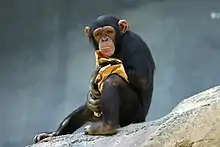
The August 2008 issue of the American Journal of Primatology reported results of a year-long study of chimpanzees in Tanzania's Mahale Mountains National Park, which produced evidence of chimpanzees becoming sick from viral infectious diseases they had likely contracted from humans. Molecular, microscopic and epidemiological investigations demonstrated the chimpanzees living at Mahale Mountains National Park have been suffering from a respiratory disease that is likely caused by a variant of a human paramyxovirus.[85]
Conservation
The US Fish and Wildlife Service finalized a rule on June 12, 2015, creating very strict regulations, practically barring any activity with chimpanzees other than for scientific, preservation-oriented purposes.[86]
See also
Notes
- ↑ At the onset of thunderstorms or sudden wind gusts chimpanzee males' hair bristles; they perform spectacular aggression displays, charging, waying back and forth, breaking off and brandishing branches. Such displays are performed more often toward the beginning of the rainy season... Rain dance is habitual at Tai Forest and Budongo and customary at Gombe, Mahale-M, Mahale-K and Kibale (Whiten et al 1999).[75]
References
- ↑ Groves, C. P. (2005). Wilson, D. E.; Reeder, D. M. (eds.). Mammal Species of the World: A Taxonomic and Geographic Reference (3rd ed.). Baltimore: Johns Hopkins University Press. pp. 182–3. ISBN 0-801-88221-4. OCLC 62265494.
- ↑ Delson, Eric (1977). "Catarrhine phylogeny and classification: Principles, methods and comments". Journal of Human Evolution. 6 (5): 433–459. doi:10.1016/S0047-2484(77)80057-2.
- ↑ Wood, B.; et al. (2013). Wiley-Blackwell Encyclopedia of Human Evolution (paperback ed.). ISBN 978-1-1186-5099-8.
- ↑ Muehlenbein, M. P. (2015). Basics in Human Evolution. Elsevier Science. pp. 114–115. ISBN 9780128026526.
- ↑ Diogo, R.; Molnar, J. L.; Wood, B. (2017). "Bonobo anatomy reveals stasis and mosaicism in chimpanzee evolution, and supports bonobos as the most appropriate extant model for the common ancestor of chimpanzees and humans". Scientific Reports. 7 (608): 608. Bibcode:2017NatSR...7..608D. doi:10.1038/s41598-017-00548-3. ISSN 2045-2322. PMC 5428693. PMID 28377592.
- ↑ "Chimpanzees among 33 breeds selected for special protection". BBC. October 28, 2017. Retrieved October 30, 2017.
- 1 2 Shefferly, N. (2005). "Pan troglodytes". Animal Diversity Web. University of Michigan Museum of Zoology. Retrieved August 11, 2007.
- ↑ Byghan, Yowann (2020). Sacred and Mythological Animals: A Worldwide Taxonomy. McFarland. p. 148. ISBN 978-1-4766-7950-1.
- ↑ Beolens, B.; Watkins, M.; Grayson, M. (2009). The Eponym Dictionary of Mammals. JHU Press.
- 1 2 Tubbs, P. K. (1985). "Opinion 1368 The generic names Pan and Panthera (Mammalia, Carnivora): available as from Oken, 1816". Bulletin of Zoological Nomenclature. 42: 365–370. BHL BioStor corrigendum in Bulletin of zoological nomenclature, 45: 304. (1988) Internet Archive BHL
- ↑ The London Magazine 465, September 1738. "A most surprising creature is brought over in the Speaker, just arrived from Carolina, that was taken in a wood at Guinea. She is the Female of the Creature which the Angolans call chimpanze, or the mockman." (cited after OED)
- ↑ "chimpanzee". American Heritage Dictionary of the English Language (5th ed.). Houghton Mifflin Harcourt Publishing Company. 2011.
- ↑ "Chimpanzee, the name of an Angolan animal […] In the year 1738, we had one of these creatures brought over into England." (cited after OED)
- ↑ Harper, Douglas. "chimpanzee". Online Etymology Dictionary.
- ↑ "chimp". Dictionary.reference.com. Retrieved June 6, 2009.
- ↑ Blumenbach, J. F. (1776). De generis hvmani varietate nativa liber. Cvm figvris aeri incisis. Goettingae: Vandenhoeck. p. 36.
- ↑ Schultes, F. W. (June 11, 2011). "Simia troglodytes".
- ↑ Lewis, C. T.; Short, C. (1879). "A little Pan, a rural deity". A Latin Dictionary. Oxford: Clarendon Press.
- ↑ Dawkins, R. (2004). "Chimpanzees". The Ancestor's Tale. Houghton Mifflin. ISBN 978-1-155-16265-2.
- ↑ Kingdon, p. 97
- 1 2 3 Fruth, B.; Hickey, J. R.; André, C.; Furuichi, T.; Hart, J.; Hart, T.; Kuehl, H.; Maisels, F.; Nackoney, J.; Reinartz, G.; Sop, T.; Thompson, J.; Williamson, E. A. (2016) [errata version of 2016 assessment]. "Pan paniscus". IUCN Red List of Threatened Species. 2016: e.T15932A102331567. doi:10.2305/IUCN.UK.2016-2.RLTS.T15932A17964305.en.
- ↑ Kingdon, p. 95
- 1 2 Humle, T.; Maisels, F.; Oates, J. F.; Plumptre, A.; Williamson, E. A. (2018) [errata version of 2016 assessment]. "Pan troglodytes". IUCN Red List of Threatened Species. 2016: e.T15933A129038584. doi:10.2305/IUCN.UK.2016-2.RLTS.T15933A17964454.en.
- ↑ Shefferly, Nancy (2005). "Pan troglodytes". Animal Diversity Web. University of Michigan. Archived from the original on August 30, 2023. Retrieved August 24, 2023.
- ↑ Israfil, H.; Zehr, S. M.; Mootnick, A. R.; Ruvolo, M.; Steiper, M. E. (2011). "Unresolved molecular phylogenies of gibbons and siamangs (Family: Hylobatidae) based on mitochondrial, Y-linked, and X-linked loci indicate a rapid Miocene radiation or sudden vicariance event" (PDF). Molecular Phylogenetics and Evolution. 58 (3): 447–455. doi:10.1016/j.ympev.2010.11.005. PMC 3046308. PMID 21074627. Archived from the original (PDF) on May 7, 2012.
- ↑ Wakeley, J. (2008). "Complex speciation of humans and chimpanzees". Nature. 452 (7184): E3–4. Bibcode:2008Natur.452....3W. doi:10.1038/nature06805. PMID 18337768. S2CID 4367089.
- ↑ Pagel, M. (June 4, 2007). "What is the latest theory of why humans lost their body hair? Why are we the only hairless primate?". Scientific American.
- ↑ King, M.-C. (1973). Protein polymorphisms in chimpanzee and human evolution (Doctoral dissertation). University of California, Berkeley.
- ↑ Minkel, J. R. (December 19, 2006). "Humans and chimps: close but not that close". Scientific American.
- ↑ Wong, K. (September 1, 2014). "Tiny genetic differences between humans and other primates pervade the genome". Scientific American.
- ↑ Gibbons, A. (June 13, 2012). "Bonobos join chimps as closest human relatives". Science/AAAS.
- ↑ McBrearty, S.; Jablonski, N. G. (2005). "First fossil chimpanzee". Nature. 437 (7055): 105–8. Bibcode:2005Natur.437..105M. doi:10.1038/nature04008. PMID 16136135. S2CID 4423286.
- ↑ Huxley, T. H. (1904). Man's Place in Nature. The new science library, v. 5. J. A. Hill and Company. p. 78. hdl:2027/uva.x000705538.
- ↑ Uehara, S.; Nishida, T. (March 1, 1987). "Body weights of wild chimpanzees (Pan troglodytes schweinfurthii) of the Mahale Mountains National Park, Tanzania". American Journal of Physical Anthropology. 72 (3): 315–321. doi:10.1002/ajpa.1330720305. ISSN 0002-9483. PMID 3578495.
- 1 2 Jankowski, C. (2009). Jane Goodall: Primatologist and Animal Activist. Mankato, MN, USA: Compass Point Books. p. 14. ISBN 9780756540548. OCLC 244481732.
- ↑ "Chimpanzee". nationalgeographic.com. National Geographic. May 10, 2011. Archived from the original on October 18, 2016. Retrieved March 21, 2017.
- ↑ "Gene study shows three distinct groups of chimpanzees". EurekAlert. April 20, 2007. Retrieved April 23, 2007.
- ↑ Tobias, P. (1971). The Brain in Hominid Evolution. New York, USA: Columbia University Press. hdl:2246/6020. ISBN 9780231035187.Schoenemann, P. T. (1997). An MRI study of the relationship between human neuroanatomy and behavioral ability (PhD thesis). University of California, Berkeley.
- ↑ Schoenemann, P. T. (2006). "Evolution of the size and functional areas of the human brain". Annual Review of Anthropology. 35 (1): 379–406. doi:10.1146/annurev.anthro.35.081705.123210.
Modern human brain sizes vary widely, but average ~1330 cc (Dekaban 1978, Garby et al. 1993, Ho et al. 1980a, Pakkenberg & Voigt 1964)
- ↑ https://oxfordre.com/psychology/display/10.1093/acrefore/9780190236557.001.0001/acrefore-9780190236557-e-50;jsessionid=0B3EA06C26BD28F03AF7CF24C88D25BB
- ↑ "Why are rat testicles so big?". ratbehavior.org. 2003–2004. Retrieved September 1, 2009.
- ↑ Maslin, M. (January 25, 2017). "Why did humans evolve big penises but small testicles?". theconversation.com. Retrieved December 22, 2018.
- ↑ Colchero, F.; Rau, R.; Jones, O. R.; et al. (2016). "The emergence of longevous populations". Proceedings of the National Academy of Sciences. 113 (48): E7681–E7690. Bibcode:2016PNAS..113E7681C. doi:10.1073/pnas.1612191113. PMC 5137748. PMID 27872299.
- ↑ Baker, K. C. (2000). "Advanced age influences chimpanzee behavior in small social groups" (PDF). Zoo Biology. 19 (2): 111–119. CiteSeerX 10.1.1.694.6985. doi:10.1002/1098-2361(2000)19:2<111::AID-ZOO2>3.0.CO;2-5.
- ↑ Segal, K. (April 21, 2012). "Meet one of the oldest chimpanzees in captivity". CNN. Retrieved October 7, 2017.
- ↑ Bauman, J. E. (1923). "The strength of the chimpanzee and orang". The Scientific Monthly. 16 (4): 432–439. Bibcode:1923SciMo..16..432B. JSTOR 6455.
- ↑ Bauman, J. E. (1926). "Observations on the strength of the chimpanzee and its implications". Journal of Mammalogy. 7 (1): 1–9. doi:10.2307/1373587. JSTOR 1373587.
- ↑ Finch, G. (1943). "The bodily strength of chimpanzees". Journal of Mammalogy. 24 (2): 224–228. doi:10.2307/1374806. JSTOR 1374806.
- ↑ Gill, V. (June 23, 2017). "Watched chimps change their hunting habits". BBC News. Retrieved June 23, 2017.
- ↑ Goodall, J. (1986). The Chimpanzees of Gombe: Patterns of Behavior. ISBN 978-0-674-11649-8.
- ↑ Guernsey, P. (July 4, 2009). "What do chimps eat?". All About Wildlife. Archived from the original on November 18, 2019. Retrieved April 22, 2013.
- ↑ Laird, C. (Spring 2004). "Social organization". Davidson College. Archived from the original on February 9, 2007. Retrieved March 10, 2008.
- ↑ "Chimp behavior". Jane Goodall Institute. Archived from the original on September 27, 2007. Retrieved August 11, 2007.
- ↑ de Waal, F. (2006). "Apes in the family". Our Inner Ape. New York: Riverhead Books. ISBN 978-1-59448-196-3.
- ↑ Holland, J. S. (2011). "40 winks?". National Geographic. Vol. 220, no. 1.
- ↑ Choi, C. Q. (April 11, 2007). "Chimps spotted using caves, like early humans". LiveScience.
- ↑ Georgiev, A. V.; Russell, A. F.; Thompson, M. E.; Otali, E.; Muller, M. N.; Wrangham, R. W. (2014). "The foraging costs of mating effort in male chimpanzees (Pan troglodytes schweinfurthii)". International Journal of Primatology. 35 (3–4): 725–745. doi:10.1007/s10764-014-9788-y. S2CID 17692801.
- ↑ "Chimpanzee intelligence". Indiana University. February 23, 2000. Archived from the original on September 17, 2016. Retrieved March 24, 2008.
- ↑ Osvath, M. (March 10, 2009). "Spontaneous planning for future stone throwing by a male chimpanzee". Current Biology. 19 (5): R190–1. doi:10.1016/j.cub.2009.01.010. PMID 19278627. S2CID 1669313.
- ↑ Mercader, J.; Barton, H.; Gillespie, J.; et al. (2007). "4,300-year-old chimpanzee sites and the origins of percussive stone technology". Proceedings of the National Academy of Sciences of the United States of America. 104 (9): 3043–8. Bibcode:2007PNAS..104.3043M. doi:10.1073/pnas.0607909104. PMC 1805589. PMID 17360606.
- ↑ Bijal, T. (September 6, 2004). "Chimps shown using not just a tool but a "tool kit"". National Geographic. Archived from the original on October 10, 2004.
- ↑ Carvalho, S.; et al. (2008). "Chaînes Opératoires and resource-exploitation strategies in chimpanzee (Pan troglodytes) nut cracking". Journal of Human Evolution. 55 (1): 148–163. doi:10.1016/j.jhevol.2008.02.005. hdl:10316/3758. PMID 18359504.
- ↑ Van Lawick-Goodall, J. (1971). Lehrman, D. S.; Hinde, R. A.; Shaw, E. (eds.). Tool-using in primates and other vertebrates. Advances in the Study of Behavior. Vol. 3. New York, USA: Academic Press. pp. 195–249. doi:10.1016/S0065-3454(08)60157-6. ISBN 9780120045037.
- ↑ Fox, M. (February 22, 2007). "Hunting chimps may change view of human evolution". Yahoo News. Archived from the original on February 24, 2007. Retrieved February 22, 2007.
- ↑ "ISU anthropologist's study is first to report chimps hunting with tools". Iowa State University News Service. February 22, 2007. Archived from the original on August 16, 2007. Retrieved August 11, 2007.
- ↑ Whipps, H. (February 12, 2007). "Chimps learned tool use long ago without human help". LiveScience. Retrieved August 11, 2007.
- ↑ "Tool use". Jane Goodall Institute. Archived from the original on May 20, 2007. Retrieved August 11, 2007.
- ↑ Wrangham, R. W. (1996). Chimpanzee cultures. Chicago Academy of Sciences, Harvard University Press. pp. 115–125. ISBN 978-0-674-11663-4.
- ↑ Samson, D. R.; Hunt, K. D. (2014). "Chimpanzees preferentially select sleeping platform construction tree species with biomechanical properties that yield stable, firm, but compliant nests". PLOS ONE. 9 (4): e95361. Bibcode:2014PLoSO...995361S. doi:10.1371/journal.pone.0095361. PMC 3989313. PMID 24740283.
- ↑ "Human-like altruism shown in chimpanzees". Science Daily. June 25, 2007. Retrieved August 11, 2007.
- ↑ Bradley, B. (1999). "Levels of selection, altruism, and primate behavior". The Quarterly Review of Biology. 74 (2): 171–194. doi:10.1086/393070. PMID 10412224. S2CID 11432622.
- ↑ Silk, J. B.; Brosnan, S. F.; Vonk, J.; et al. (2005). "Chimpanzees are indifferent to the welfare of unrelated group members". Nature. 437 (7063): 1357–9. Bibcode:2005Natur.437.1357S. doi:10.1038/nature04243. PMID 16251965. S2CID 8440378.
- ↑ Boesch, C.; Bolé, C.; Eckhardt, N.; Boesch, H. (2010). Santos, L. (ed.). "Altruism in forest chimpanzees: the case of adoption". PLOS ONE. 5 (1): e8901. Bibcode:2010PLoSO...5.8901B. doi:10.1371/journal.pone.0008901. PMC 2811728. PMID 20111704.
- ↑ Zuberbühler, K.; Langergraber, K.; Schel, A. M.; Hobaiter, C. (2014). "'Adoption' by maternal siblings in wild chimpanzees". PLOS ONE. 9 (8): e103777. Bibcode:2014PLoSO...9j3777H. doi:10.1371/journal.pone.0103777. ISSN 1932-6203. PMC 4118915. PMID 25084521.
- 1 2 Harrod, J. (May 10, 2007). "Appendices for chimpanzee spirituality: a concise synthesis of the literature" (PDF). Archived from the original (PDF) on May 27, 2008. Retrieved January 28, 2011.
- ↑ Archived at Ghostarchive and the Wayback Machine: Chimpanzee talking. YouTube. August 17, 2007. Retrieved August 28, 2015.
- ↑ "Communication". Evolve. Season 1. Episode 7. September 14, 2008.
- ↑ Walsh, B. (February 18, 2009). "Why the Stamford chimp attacked". TIME. Archived from the original on February 19, 2009. Retrieved June 6, 2009.
- ↑ Teelen, S. (2008). "Influence of chimpanzee predation on the red colobus population at Ngogo, Kibale National Park, Uganda". Primates. 49 (1): 41–9. doi:10.1007/s10329-007-0062-1. PMID 17906844. S2CID 19914188.
- ↑ Gibbons, A. (2007). "Primate behavior. Spear-wielding chimps seen hunting bush babies". Science. 315 (5815): 1063. doi:10.1126/science.315.5815.1063. PMID 17322034. S2CID 40430973.
- ↑ Pruetz, J. D.; Bertolani, P. (2007). "Savanna chimpanzees, Pan troglodytes verus, hunt with tools". Current Biology. 17 (5): 412–7. doi:10.1016/j.cub.2006.12.042. PMID 17320393. S2CID 16551874.
- ↑ Gray, R. (February 24, 2013). "Chimps solve puzzles for the thrill of it, researchers find". Daily Telegraph. Retrieved February 24, 2013.
- ↑ Goodall, J. (1986). The Chimpanzees of Gombe: Patterns of Behavior. Cambridge, Massachusetts: Belknap Press of Harvard University Press. ISBN 978-0-674-11649-8.
- ↑ "Researchers find human virus in chimpanzees". Newswise. June 3, 2008.
- ↑ "U.S. Fish and Wildlife Service finalizes rule listing all chimpanzees as Endangered under the Endangered Species Act". U.S. Fish and Wildlife Service. Retrieved August 30, 2016.
Certain activities involving chimpanzees will be prohibited without a permit, including import and export of the animals into and out of the United States, "take" (defined by the ESA as harm, harass, kill, injure, etc.) within the United States, and interstate and foreign commerce. Permits will be issued for these activities only for scientific purposes that benefit the species in the wild, or to enhance the propagation or survival of chimpanzees, including habitat restoration and research on chimpanzees in the wild that contributes to improved management and recovery.
Sources
- Kingdon, Jonathan (2015). The Kingdon Field Guide to African Mammals (Second ed.). Bloomsbury Publishing. ISBN 978-1-4729-2531-2.
Further reading
- Hawks, John. "How Strong Is a Chimpanzee?". Slate. February 25, 2009.
- Pickrell, John. (September 24, 2002). "Humans, Chimps Not as Closely Related as Thought?". National Geographic. Archived September 7, 2017.
- Zimmer, Carl. "On the Origin of Humans' Generosity". The New York Times. September 11, 2018.
External links
 The dictionary definition of chimpanzee at Wiktionary
The dictionary definition of chimpanzee at Wiktionary Media related to Pan at Wikimedia Commons
Media related to Pan at Wikimedia Commons- Ingersoll, Ernest (1920). . Encyclopedia Americana.
- Lydekker, Richard (1911). . Encyclopædia Britannica (11th ed.).
- Stanford, Craig B. The Predatory Behavior and Ecology of Wild Chimpanzees Archived June 29, 2010, at the Wayback Machine university of Southern California. 2002(?)
- ChimpCARE.org
- View the panTro4 genome assembly in the UCSC Genome Browser.
- Human Timeline (Interactive) – Smithsonian, National Museum of Natural History (August 2016).

_feeding.jpg.webp)
